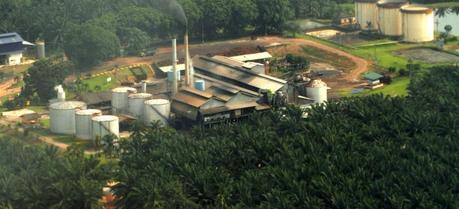 A palm oil plantation at Sepang, Malaysia. (Credit: Flickr @ Marufish http://www.flickr.com/photos/marufish/)
A palm oil plantation at Sepang, Malaysia. (Credit: Flickr @ Marufish http://www.flickr.com/photos/marufish/)An analysis published Feb. 26 in the journal Nature Climate Change (see footnote) shows that the wastewater produced during the processing of palm oil is a significant source of heat-trapping methane in the atmosphere. But the researchers also present a possible solution: capturing the palm oil methane and using it as a renewable energy source.
The methane bubbling up from a single palm oil wastewater lagoon during a year is roughly equivalent to the emissions from 22,000 passenger vehicles in the United States, the analysis found. This year, global palm oil methane emissions are expected to equal 30 percent of all fossil fuel emissions from Indonesia, where widespread deforestation for palm oil production has endangered orangutans.
“This is a largely overlooked dimension of palm oil’s environmental problems,” said lead author Philip Taylor, a postdoctoral researcher at CU-Boulder’s Institute of Arctic and Alpine Research (INSTAAR). “The industry has become a poster child for agriculture’s downsides, but capturing wastewater methane leaks for energy would be a step in the right direction.”
The global demand for palm oil has spiked in recent years as processed food manufacturers have sought an alternative to trans fats.
For now, the carbon footprint of cutting down forests to make way for palm plantations dwarfs the greenhouse gases coming from the wastewater lagoons. But while deforestation is expected to slow as the focus shifts to more intensive agriculture on existing plantations, the emissions from wastewater lagoons will continue unabated as long as palm oil is produced, the researchers said.
However, the climate impact of the leaking palm oil methane could be mitigated by capturing the gas and using it to fuel power plants. Biogas technology has been used successfully for decades and it can produce renewable electricity at a cost that’s competitive with traditional fuels, the authors said.
The amount of methane biogas that went uncollected from palm oil wastewater lagoons last year alone could have met a quarter of Malaysia’s electricity needs. Tapping into that unused fuel supply could yield both financial and environmental benefits, the authors said.
Capturing methane at wastewater lagoons could be encouraged by making it a requirement before palm oil products can be certified as sustainable, the authors said. Current sustainability certifications do not address wastewater emissions.
Taylor, whose research typically focuses on carbon cycling in old-growth tropical forests, was inspired to do the analysis by undergraduate researcher Hana Fancher, who also is a co-author of the journal article. Fancher and Taylor were doing research in Costa Rica, where palm oil production is spreading, when Fancher became curious about how the oil was being processed.
“She has a wastewater background,” Taylor said. “She ended up doing an honors thesis on palm oil agriculture and wastewater emissions. This paper is an extension of that thinking.”
Taylor, P., Bilinski, T., Fancher, H., Cleveland, C., Nemergut, D., Weintraub, S., Wieder, W., & Townsend, A. (2014). Palm oil wastewater methane emissions and bioenergy potential Nature Climate Change, 4 (3), 151-152 DOI: 10.1038/nclimate2154
